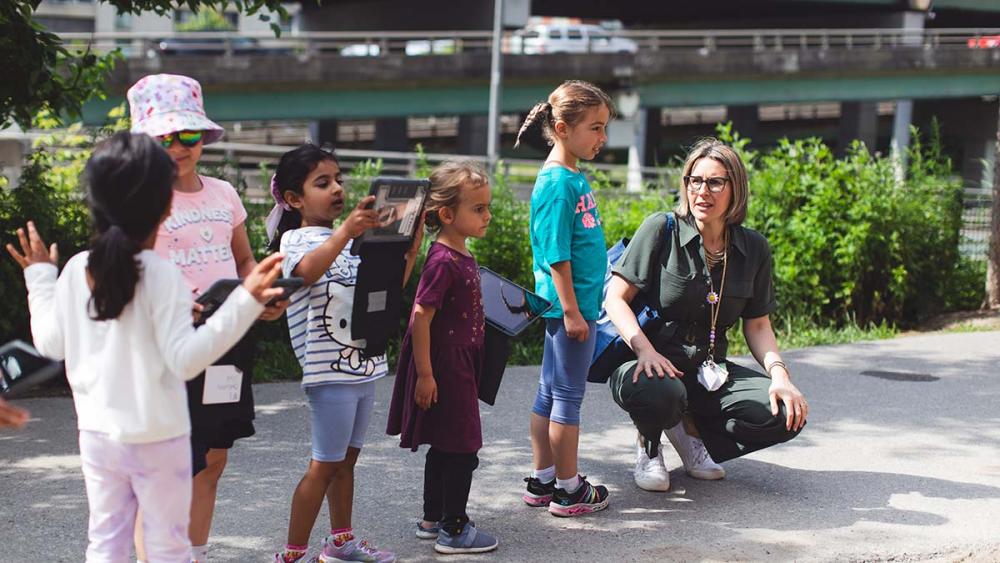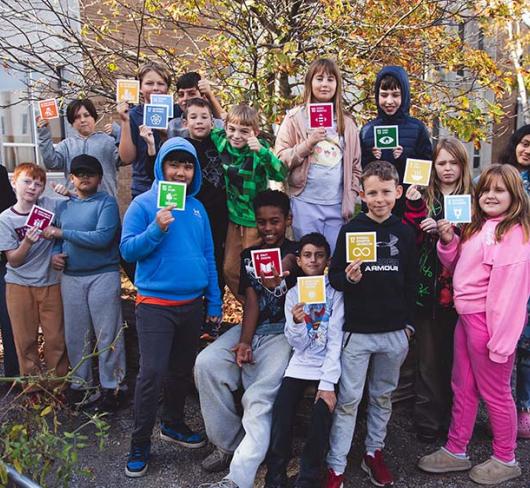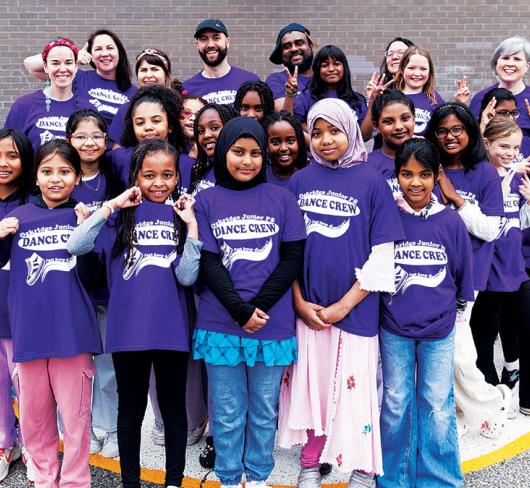
Taking a Walk Through and About Media Literacy
A group of kindergarten children walks two-by-two, with iPads in hand, through the urban streets and walking trails of our community in downtown Toronto. The children chat enthusiastically while capturing photos and short video clips of their favourite climbing structure at the park, an interesting sign, a beautiful flower on a spring day, a tall tree! They then return to the classroom to engage in collaborative media-making experiences.
This is an example of what media literacy education looks like in our classroom community. How is this media literacy education? Well, take a walk with me and I’ll share a little about how easy it is to get started with media literacy.
This past year marks what I could call my 11-year anniversary of learning and unlearning all things media literacy. I was always drawn to using multimodal texts like books, commercials, music and websites to support student learning along with field trips and community outings. Throughout the completion of my specialist certificate in media literacy, my colleagues at the Association for Media Literacy (AML) helped me understand that media literacy is more than tangible texts and includes the environments in which our students live and learn.
Although I currently teach Kindergarten, the community walk experience is easily scalable for Kindergarten to Grade 8 students and beyond. This broad and inclusive approach gives educators permission to seamlessly integrate media literacy across the curriculum. Combined with the strategy of teaching not just through media, but about it, this integration helps students become more aware of the role and impact of media in their lives. Community walks are a collective experience that immediately engages students and situates educators and students as co-learners in a neighbourhood media exploration where learners see themselves reflected in the curriculum.
What is Media Literacy?
As we know, the revised Ontario Language curriculum embeds a multimodality approach to language teaching and learning. The approach is essentially a “text as media” inquiry (i.e., media literacy) approach, inviting questions about how texts communicate meaning through various modes and cultural contexts. I already knew that bringing multimodal texts into the classroom engages students. And since many of Ontario’s curriculum documents centre on themes of identity and encourage inquiry processes, I knew that the community walk experience would provide a perfect opportunity to learn through multimodal texts and connect across the curriculum, for example to Social Studies/History (urban cultural identity), or Geography and Mathematics (map-making).
Marshall McLuhan reminded us that “the medium is the message,” meaning that we should pay attention to media forms and their effects as well as (if not more than) their content. This is where one of the key media literacy pedagogies – teaching through and about – naturally occurs. This approach helped me realize I was often too focused on using texts as a vehicle for teaching curricular content, but not teaching about the texts themselves. The community walk enables this shift in perspective by focusing on the common but often “invisible” details of neighbourhoods, like stop signs, traffic lights or architecture.
Our weekly community walk is a mini field trip that always generates lots of excitement. As students document sounds and images, they develop voice and agency. They are keen to point out different signs, excited by the fact they can “read” the environmental print, but also puzzled and quick to inquire about signs that seem unfamiliar or even unfair.
AML’s Media Literacy Triangle, a graphic framework for understanding key concepts in media literacy, comes in handy as a tool to support critical thinking about media, providing prompts for examining the relationship between text, audience and producer. I use triangle questions such as How might different people understand this sign? What colours or shapes do you see? Why is this here? to push student thinking forward within our deceptively ordinary environment.
As our learning community continues the walk, I notice that students begin to understand that street signs have the power to tell people (including the children) what they can and cannot do, illustrating a growing awareness about the social and political relationships that are present in cultural texts and how these texts inform their daily lives. Again, the AML’s media triangle – and their media literacy key concepts – are effective frameworks for learning about bias, values messages, and economic implications.
The concepts may seem complicated but are really quite simple. For example, the children notice a sign that depicts a camera or CCTV. We regularly use cameras to document our learning and the kids are familiar with consent and of what or who we can and cannot take photographs. The students discuss their discomfort with having their images captured on camera without their consent. Here is a critical literacy learning opportunity to further develop awareness about media codes and conventions, as well as the circulation of social and political messages.
For deeper exploration of representation of diverse groups, issues, and perspectives, the modified Anti Bias and Anti Racist Media Triangle (ABAR) handily delivers. The media triangle in all its iterations serves as a valuable framework for exploring our complex relationships with society. It acts as a useful tool for me to engage, question or expand on children’s expressions of their thinking, creating a space for layered experiences in collaborative inquiry and reflection.
Digital Media Literacy/Production
When the children return to the classroom after the community walk, there is much commotion as they curate the photos and videos, re-experiencing memories and sights from the day. They talk together and review interesting material, placing favourite photographs in a collaborative slide deck. Now the focus is on production and creation in various forms. Students use Clips, an iPad app, to select interesting signs and describe shapes they see in the signs or how they might change or improve the signs for readability. As a part of our co-created classroom community agreements, the children regularly photograph their work and then capture a short voice recording that automatically uploads to a digital portfolio for each child.
As transferable skills, digital and media literacy sit in Strand A, the broad “umbrella” strand that is the context for all the other Language learnings, such as communication and comprehension. When students digitally create responses to their walk, they play, experiment, investigate and discover its full possibilities and limitations. They have space to transform, express and refine their ideas through an inquiry and iterative process. All the Language learnings are at play. When layered with digital tools especially, the experiences are positive, enjoyable and change-making.
Media production does not always have to be digital to allow children to deeply engage with and represent their learning experiences and ideas. In our classroom, the children work with loose parts (open-ended materials). It is a particularly powerful production tool that supports kids in their representation of their understanding of inquiries. After our walk, I might ask students to create their own signs or re-imagine how they could remix or recreate the signs they saw. For example, a child notices that people often let their dogs run in the garden bed that is below our classroom window. They carefully arrange various loose parts in the form of red, white, and yellow gems and wooden blocks to create their own sign. The student explains that “this sign is for the flower garden.” It warns – through the use of red and yellow (media codes and conventions) – that people cannot enter the garden and to watch for flowers. This child’s production involves creating media content through analogue visual representations and also demonstrates learning about the codes and conventions of signs.
Conversations develop from the sights, sounds and memories captured on the walk and the children are able to use these experiences as a springboard to reading, writing, speaking and listening. While reviewing the signs we noticed, I ask students to engage in reading environmental print in its real-world context. For example, many of the signs we see use the word “No,” or imply through imagery and colour that they are meant to alert and control people in the community. Here, they are considering the use of words or phrases to communicate meanings and influence audiences. This exploration of signs also develops their understanding of how vocabulary, combined with images, influences the social and cultural meanings of texts, which happens to be a key media literacy concept. It becomes a cross-curricular language development conversation – especially in the Early Years.
The walk also activates other aspects of Strand A, such as engaging with texts that foster “understanding of diverse identities, experiences, [and] perspectives.” So, at another time, the walk might embed First Nations, Métis or Inuit perspectives and world views. (ETFO has resources to get you started online at etfofnmi.ca.)
As noted, the revised Language curriculum centres on a multimodality approach, recognizing a “text” as any means of communication (e.g., words, graphics, sounds, or images), also known as “texts as media.” In a multimodal learning environment, then, ‘’production’’ has a broad definition: it can mean a sketched storyboard or a drafted paragraph in response to explored concepts, digital or handwritten. As Michelle Solomon, director at the Association for Media Literacy, explains, words themselves are media texts.
I have often asked students to engage in multimodal production that also makes crosscurricular connections. I once had students curate photos taken on a walk and then create a digital journal explaining what they liked about their community, allowing them to tell stories important to them. Students might also interview local community business owners and create a tapestry of stories told from diverse perspectives. Geography can be integrated through map making, where students create maps of their community or look back at archived maps (links to history). Educators might also ask students to explore community spaces where art installations (e.g., murals, sculptures) might be found.
Because the community walk seamlessly allows multiple entry points for critical engagement with learning and documentation about it, and for teaching through and about media, it is a rich, layered and accessible experience that can be embedded in virtually any program.
Throughout my career, media literacy has always been there because media literacy is everywhere. My hope is that the community walk can offer educators and students multiple entry points for integrating media literacy inquiry across the curriculum. Media literacy is critical thinking that enables all people to evaluate consumed and created media messages. Doing the work of media literacy invites students to understand how media affects their lives and their society, but also how to express themselves as media users and makers. The invitation to come along on a walk is just the beginning of a limitless opportunity to co-create innovative learning experiences.
Thanks to Neil Andersen for showing me the possibilities of a walk and Carol Arcus for her support through the writing process.
Chelsea Attwell is a member of the Elementary Teachers of Toronto.
The Triangle: Media Literacy's Favourite Shape!
Media Literacy Triangle
The Media Literacy Triangle is a graphic framework that was presented to the AML by Eddie Dick of the Scottish Media Council. It is based on the key concepts of media literacy but can be used by teachers and students directly in classrooms to facilitate and organize discussions and analyses. The Anti-Racist and Anti-Bias Media Triangle This useful framework/tool reconfigures the key concepts of media literacy to mobilize critical thinking about anti-bias anti-racism (ABAR) issues. All ABAR themes are media-related because bias – and racism through bias – are communicated through media forms and environments.
Fake News Triangle
What is new about fake news? As with all news in the 21st century, it is more frequent and easier to encounter, but harder to verify. Where once professional editors filtered news for accuracy and honesty, we more often find that we have to perform that job ourselves.
Social Media Triangle
The Social Media Triangle was designed for the OTF/OADE Social Media and Teacher Learning Conference in February 2012. It is an amalgam of the Media Literacy Triangle and critical literacy questions. The questions are designed to facilitate critical thinking about social media and help students use it effectively.
Early Years Definition of Media Literacy
This foundation of understanding media can be used with children as young as three years.
- Media are made by people, for people
- We can see them
- We can hear them
- We can feel them
- We can wear them
- We can experience them
- All media have a message
Source: Association for Media Literacy (aml.ca)

